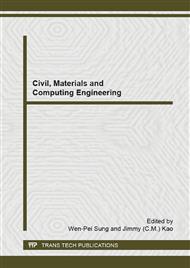p.177
p.183
p.187
p.191
p.195
p.198
p.202
p.207
p.212
CWR Study of the Mechanical Properties of the Finite Element Method-Based Bridge Vertical Plate Non-Ballasted Track
Abstract:
With economic development, China’s railway construction is also rapidly developing and its technical requirements are also increasing. In recent years, CWR technology is most used in railway construction, the railway built using this technology is not only smooth, comfortable, but also long life and low maintenance costs, being widely used in railway construction. However, due to restrictions on the production technology and construction conditions, CWR will also be worn, broken, bent, etc., which requires people to continue to study techniques to prevent crawling or off the seam value of rail gauge, to ensure that rail transport safety. This article focuses on the finite element method-based bridge vertical plate non-ballasted track CWR mechanical properties.
Info:
Periodical:
Pages:
195-197
Citation:
Online since:
December 2014
Authors:
Price:
Сopyright:
© 2015 Trans Tech Publications Ltd. All Rights Reserved
Share:
Citation:


